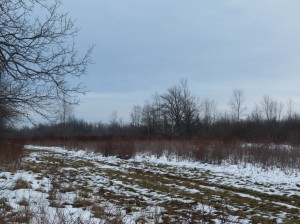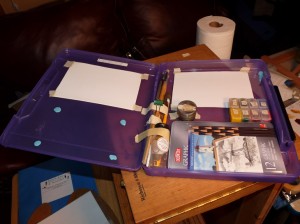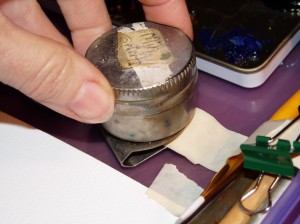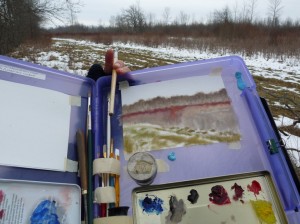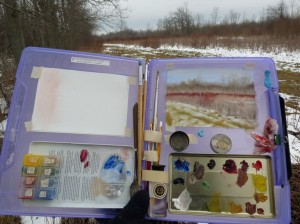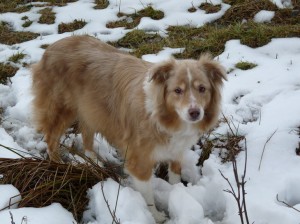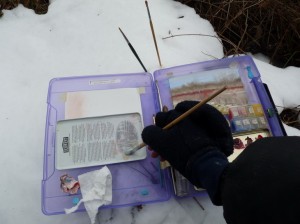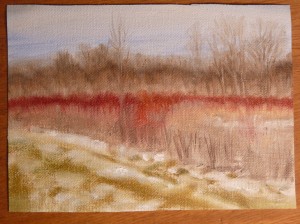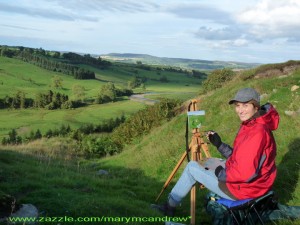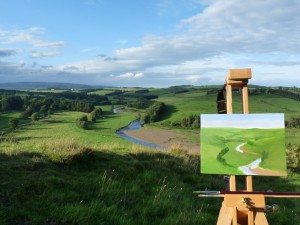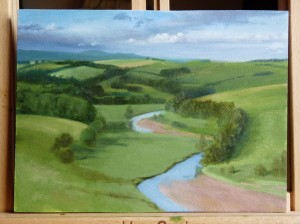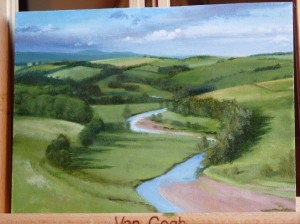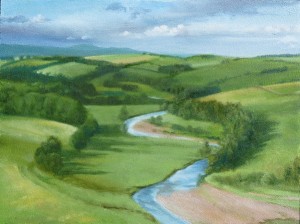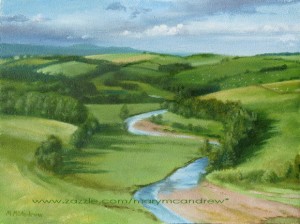(Please click each picture to see it enlarged)
It is a cold and dreary day here in Western New York, I guess it is in many places around the world. But the drippy dreariness also shows me spring is coming; snow melting on soggy but still frozen ground, dripping of ice from the trees and an almost silent occasional gurgle of air from under the ice as I worked quietly.
I created this lightweight kit to take outside with me, just for oil painting sketches. I mostly want to focus on practicing mixing colors for landscapes from the real thing. I’m not concerned about finished paintings, though as the weather is warmer I may work longer on them.
It’s a plastic box that I bought at an office supply store. I used a metal pencil box for my paint and as a palette; it’s held on with blue sticky tack. I also have a pill box that has colors in it, though I want to buy a long one so it will fit better. I have canvas paper cut to standard sizes and tape it in and also created a place for brushes with loops of masking tape.
I had a tiny plastic bottle of mineral spirits with me but didn’t need to pull it out, I had a tiny bit in this metal medium cup. It’s got a screw on lid and I created a strap with masking tape that it could slip over to hold it in place. Then I stuck a blob of blue sticky tack behind it to keep it from slipping off. (Just love that sticky tack!)
It was very lightweight as I worked. As all tests should do, it helped me find what was ‘not’ working great; I need to make a little holder for dirty brushes on the left and both need a holder with some kind of bottom, like a pouch. My brushes were sliding out the bottom too easily and may get dropped.
Here’s the whole thing in progress. Note the paper towel with red paint all over it!! Ok, I admit it, the very first thing, when I lifted the lid of the metal pan (with my very cumbersome mittens on) I inadvertently got Cadmium Red paint on my mitten thumb, WITHOUT KNOWING IT! It suddenly showed up in three to four places, probably on my face too and I didn’t know it! Ok, those who paint with oils know that sometimes this just happens, oil paint likes to migrate. Cad Red is one of the worse to get on stuff! You see traces of where I had to scrub off the second canvas paper there, sigh. Nobody’s perfect.
Ginger loves to go out on walks, but gets bored when I stop to paint or sketch. Today was worse because her feet were cold! But a good sign, when I was ready to leave, she didn’t turn towards home, she wanted to go further.
When I’m done, I set the kit on the snow and stuck my dirty brushes in the snow (bottom down) and just dipped the tip of each one in mineral spirits and pushed on the lid/palette to work much of the paint out. Wipe it really well on paper towel, it won’t be clean but well enough to travel home for cleaning. Most of my brushes I used were bristle brushes for scumbly strokes and one small, flat, soft but firm nylon brush for the thin line strokes.
Here’s the quicky field sketch fresh from the icy field. I know my colors look brighter than the photo, but that’s the beauty of painting from life, the colors were more vivid and beautiful to my eyes, a photo will lose a lot of true color and atmosphere. If I want I can let this dry and work more on it or do it while it’s still wet. Ideally, touch up what you want right when you return and it’s fresh in your mind. I don’t want to fuss too much over these sketches unless I do one that I feel is worthy of fussing. My main goal is to just get out and get quick color studies and not complicate things too much.
Hope you enjoyed, I’ll be trying out my field kit more and will keep you ‘posted’ as they say! haha.
Happy New Year everyone! I’m looking forward to a year filled with tons of new paintings by me and look forward to getting back to England for more adventures! Please share my blog with those you think would enjoy it.
